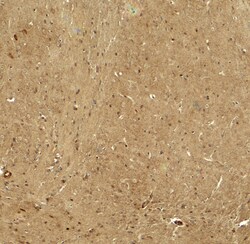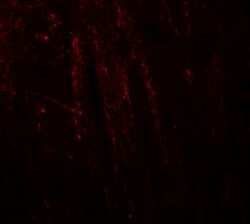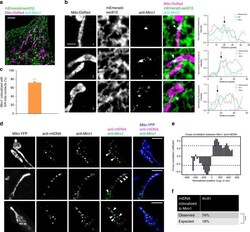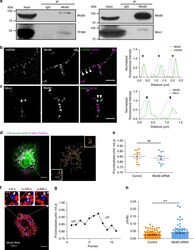Antibody data
- Antibody Data
- Antigen structure
- References [1]
- Comments [0]
- Validations
- Immunohistochemistry [2]
- Other assay [2]
Submit
Validation data
Reference
Comment
Report error
- Product number
- PA5-72835 - Provider product page

- Provider
- Invitrogen Antibodies
- Product name
- RHOT1 Polyclonal Antibody
- Antibody type
- Polyclonal
- Antigen
- Synthetic peptide
- Reactivity
- Human, Mouse, Rat
- Host
- Rabbit
- Isotype
- IgG
- Vial size
- 100 μg
- Concentration
- 1 mg/mL
- Storage
- Store at 4°C short term. For long term storage, store at -20°C, avoiding freeze/thaw cycles.
Submitted references ER-mitochondria contacts promote mtDNA nucleoids active transportation via mitochondrial dynamic tubulation.
Qin J, Guo Y, Xue B, Shi P, Chen Y, Su QP, Hao H, Zhao S, Wu C, Yu L, Li D, Sun Y
Nature communications 2020 Sep 8;11(1):4471
Nature communications 2020 Sep 8;11(1):4471
No comments: Submit comment
Supportive validation
- Submitted by
- Invitrogen Antibodies (provider)
- Main image

- Experimental details
- Immunohistochemistry of RHOT in mouse brain tissue with RHOT1 Polyclonal Antibody (Product # PA5-72835) at 5 µg/mL.
- Submitted by
- Invitrogen Antibodies (provider)
- Main image

- Experimental details
- Immunofluorescence of RHOT in mouse brain tissue with RHOT1 Polyclonal Antibody (Product # PA5-72835) at 20 µg/mL.
Supportive validation
- Submitted by
- Invitrogen Antibodies (provider)
- Main image

- Experimental details
- Fig. 3 Miro1 is enriched at EMCS and spatially associated with mtDNA. a A multicolor SIM image of a Cos-7 cell expressing mEmerald-Sec61beta and mito-DsRed, with Miro1 labeled with alpha-Miro1 antibody. b Higher magnifications of the boxes in a showing three examples of Miro1 enriched at EMCS. White arrowheads indicate Miro1 punctae. Graphs to the right show relative pixel intensities of mito-DsRed, anti-Miro1, and mEmerald-Sec61beta from a linescan drawn on each corresponding image (dashed line). The white arrowheads correspond to the black arrows on the linescans. c The percentage of Miro1 punctae that colocalized with the ER-mitochondria contacts in fixed Cos-7 cells. Data are shown as mean +- SEM ( n = 10 cells examined over three independent experiments). d Cos-7 cells were transfected with mito-YFP, and immunostained by anti-Miro1 and anti-mtDNA. Arrowheads show mtDNA foci with adjacent Miro1 foci. e Spatial cross-correlation analysis of mtDNA and Miro1 fluorescence intensity along linescans of mitochondria ( n = 91 mtDNA from 17 images) in fixed Cos-7 cells. Blue dotted lines indicate 95% confidence interval cutoffs, corresponding to the position of 224 nm. f Percentage of mtDNA that colocalized with Miro1 in Cos-7 cells (distance < 224 nm), corresponding to the 95% confidence interval marked by the blue dotted lines in e . Significantly more mtDNA is spatially (74%) associated with Miro1 than that expected by a randomly scrambled distribution (19%; n = 91 mtDNA from 1
- Submitted by
- Invitrogen Antibodies (provider)
- Main image

- Experimental details
- Fig. 4 Mic60 links mtDNA to Miro1 and contributes to EMCS stability. a Co-immunoprecipitation of Mic60 with endogenous TFAM and Miro1 in HEK293T cells, and the immunoprecipitates were blotted as indicated. Input: 2%. b Cos-7 cells immunostained by anti-mtDNA and anti-Mic60. Arrowheads show mtDNA foci with adjacent Mic60 foci. (Right) the graph is linescan drawn through the mitochondria, and show the relative fluorescence intensity of mtDNA (green) and Mic60 (purple) along their length. White arrow positions correspond to black arrows on the linescan. c As in b for cells immunostained by anti-Miro1 (green on linescan) and anti-Mic60 (purple on linescan). d Dual-color confocal image of a Cos-7 cell expressing mito-DsRed and mEmerald-Sec61beta (left), and the corresponding mitochondrial perimeter profile (right). Mitochondrial perimeter profiles are presented by red pixels, and the contacts between the mitochondrial perimeter and the ER are presented by yellow pixels. e ER-mitochondria colocalization index ( R ), calculated as the ratio between the perimeter pixels of mitochondria colocalized with the ER and the total perimeter pixels of mitochondria for the control and Mic60 RNAi cells ( n = 10 cells were used per condition from three independent experiments). f Fluorescence image (modified as described in ""Methods"" section) of a Mic60 RNAi cell expressing mito-DsRed and mEmerald-Sec61beta. The boxed region is enlarged and shows time-lapse images. White arrowheads indicate un
 Explore
Explore Validate
Validate Learn
Learn Western blot
Western blot ELISA
ELISA Immunohistochemistry
Immunohistochemistry